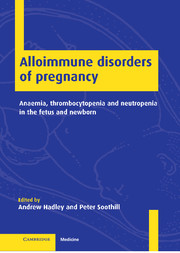 Alloimmune Disorders of Pregnancy
Alloimmune Disorders of Pregnancy Published online by Cambridge University Press: 26 October 2009
The first evidence that passively administered antibody could suppress the immune response to the corresponding antigen was documented a century ago. Since then, the administration of anti-D to D-negative individuals has become firmly established as an effective measure to prevent alloimmunization to D. Anti-D prophylaxis is the most widespread clinical application of specific antibody-mediated immune suppression. This chapter first reviews the historical background and some of the early experimental and clinical studies on the prevention of RhD alloimmunization. The essential characteristics and possible theories to explain the mechanism of action of prophylactic anti-D are then discussed. Finally, progress made towards the introduction of monoclonal anti-D is reviewed.
Haemolytic disease of the fetus and newborn due to anti-D
About 50 years ago, there were at least 1000 neonatal deaths a year in England and Wales from HDFN, an incidence of approximately 150 per 100000 births. At a large hospital – Queen Charlotte's in London – between 1946 and 1949, the neonatal death rate was even higher, at 3.2 per 1000. Stillbirths represented an additional 30% of cases. In the early 1940s in Manitoba, Canada, 10% of perinatal deaths were due to HDFN and the death rate of affected babies was 40% Improved obstetric and neonatal care resulted in a 10-fold reduction in the number of deaths, first as a result of the introduction of neonatal exchange transfusion, then premature delivery and, finally, as a result of intrauterine transfusion, either intraperitoneally or, more recently, by ultrasound-guided delivery into the umbilical cord vessels.
To save this book to your Kindle, first ensure [email protected] is added to your Approved Personal Document E-mail List under your Personal Document Settings on the Manage Your Content and Devices page of your Amazon account. Then enter the ‘name’ part of your Kindle email address below. Find out more about saving to your Kindle.
Note you can select to save to either the @free.kindle.com or @kindle.com variations. ‘@free.kindle.com’ emails are free but can only be saved to your device when it is connected to wi-fi. ‘@kindle.com’ emails can be delivered even when you are not connected to wi-fi, but note that service fees apply.
Find out more about the Kindle Personal Document Service.
To save content items to your account, please confirm that you agree to abide by our usage policies. If this is the first time you use this feature, you will be asked to authorise Cambridge Core to connect with your account. Find out more about saving content to Dropbox.
To save content items to your account, please confirm that you agree to abide by our usage policies. If this is the first time you use this feature, you will be asked to authorise Cambridge Core to connect with your account. Find out more about saving content to Google Drive.